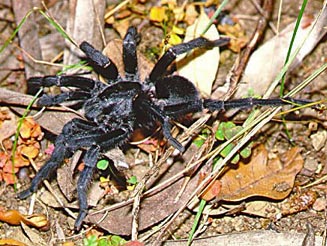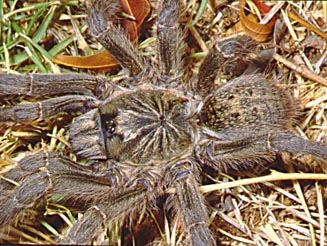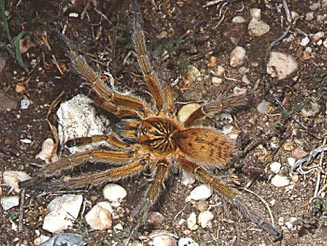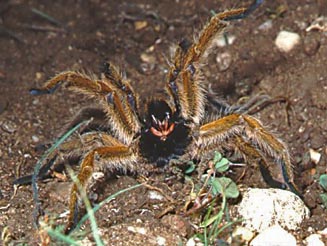|
Family: Theraphosidae (baboon spiders)
Life
> Eukaryotes
>
Opisthokonta >
Metazoa
(animals) > Bilateria > Ecdysozoa > Panarthropoda > Tritocerebra >
Arthropoda > Arachnomorpha > Cheliceriformes > Chelicerata > Euchelicerata
> Arachnida > Araneae
> Mygalomorpha
|

|

|
|
Harpactira baviana (male). [image N. Larsen
©] |
Harpactira chrysogaster (female). [image N.
Larsen ©] |
|

|

|
|
Harpactira atra (male). [image N. Larsen
©] |
Ceratogyrus sp.(image by Dr. M
Filmer, used with permission) |
African species are called baboon spiders due to their hairy appearance and the black
scopulae pads on its "feet" resembling the pads on baboon feet. These spiders are often incorrectly referred to as
tarantulas, a name usurped by the
American species from the European wolf spider (family Lycosidae) Lycosa
tarantula.
This family belongs to the suborder Mygalomorpha. This is a primitive spider group that
some scientists believe should belong to its own order as, for example, the scorpions.
These harmless giants are often negatively portrayed as villainous monsters especially in
movie industry. They are not dangerous to man although they can inflict a painful bite.
They are all mildly venemous, the venom being neurotoxic. However, the smaller species
from the Western Cape, Harpactirella lightfooti is reputed to be dangerous to man
although there is no evidence of this.
In South Africa this family is represented by five genera including thirty-four described
species. Ceratogyrus, the horned baboon spider, is distributed across the northern parts
of South Africa and its bordering countries.
Harpactira the common
baboon spider, occurs over the whole of South Africa and bordering countries.
Pterinochilus, the golden-brown baboon spider occurs from north-eastern South Africa
northwards to Ethiopia.
There are two lesser baboon spiders, Brachionopus, which is rare and is restricted to the
eastern parts of South Africa and Harpactirella that occurs in the southern parts of South
Africa.
All South African species are terrestrial occurring in underground burrows or scrapes
under rocks. The scrape is lined with thick silk, which is attached to the rock and keeps
out troublesome insects such as ants. At night, the burrow dwellers can be seen with their
front legs and eyes showing at the entrance of their burrows as they wait for unsuspecting
prey.
Females usually stay close to their retreat while the males, once mature, roam freely
looking for a mate. For this reason, most of the specimens brought to the Museum for
identification are males.
Theraphosids are large, bulky and hairy with a body length of 13-90 mm long with the
average spider measuring 20-50 mm. They have robust non-tapering legs and the pads or
scopulae setae under the "feet" allow them to walk up the smoothest of surfaces
- even glass.
Most theraphosids are difficult to identify due to the lack of distinctive external
characters. However, Ceratogyrus is easy to identify by the distinctive horn or plug
projecting from carapace. The shape of this projection is used to identify to species.
Normally this projection is fixed but during a moult is rotates slowly and is used to
loosen the old skin. Species without this projection have instead a groove (fovea) and
they use other means for loosening the skin.
The most dramatic feature of these spiders is the black fangs that can
exceed 6 mm
in length and are parallel to each other (paraxial). The fangs are set into the jaws
(chelicerae) that project forward (porrect). These spiders are black and hairy underneath
(ventrally) except in the region of the fangs where the hair colour rnages from
orange to a pink/red tinge. During an
attack, the forelegs are raised in aggression, exposing the fangs and the orange and black
colouration. Dorsally the colouration
varies enormously ranging from black, various shades of brown and shades of copper and
cinnamon. The abdomen can be plain or marked with spots or chevrons.
 |
|
|
Harpactira atra threat display. [image
N. Larsen ©] |
|
The eight eyes are arranged on the carapace on a central tubercle set back slightly from
the anterior (front) edge of the carapace. This is called the clypeus and if there is no
clypeus, one can be assured that the spider is not a theraphosid but another family
instead (either Barychelidae, Cyrtauchenidae or Nemesiidae). All mygalomorphs have two
pairs of ventral booklungs that operate on the principle of infusion rather than the more
efficient system of inhalation. These spiders are therefore not very active and tire
easily.
In other spider families, the males are easily recognised by the expanded ends of the
palps where the sperm-carrying organ, the embolus, is situated. The expanded palp ends are
not that noticeable in male theraphosids but males can also be recognised by the less
bulky abdomen and by a tibial spur situated ventrally on the distal aspect of the tibia of
the first pair of legs. The spur is not obvious as it is concealed amongst long hairs
(setae) and rather resembles a pointed brush. The spur is used to restrain the females'
fangs during copulation.
The female lays 30 to 180 eggs but very few survive the 7 to 10 year maturity period.
Unlike the true spiders, the araneomorphs, the mygalomorph females continue to moult after
reaching maturity and can live for about 25 years. The males live for only about 6 months
after maturity and therefore it is of no consequence should the females consume them.
Due to the slow maturity rate and high mortality of immatures, the collecting of baboon
spiders is strongly discouraged, as this has led to the decimation of populations. They do
not make ideal pets as they are inactive during the day and move around very little even
at night. Once the novelty of scaring ones friends has worn off, most spiders in captivity
eventually die of dehydration, stress from handling and sheer neglect.
As mentioned above, theraphosids are harmless to man although the bite is painful and
mildly neurotoxic. If bitten, one will experience an intense burning pain in the region of
the bite where two red blood spots will develop from the fang punctures. There will be no
evidence of discolouration and swelling. Depending on the species, the pain will subside
after 2-18 hours. There might be symptoms of shock. The only treatment required would be a
painkiller and antihistamine. However, as mentioned earlier, Harpactirella
lightfooti is
thought to be harmful to man although there is no evidence of this.
Some American species defend themselves by creating a cloud of barbed (urticating) hairs
by rubbing them off their abdomens often leaving two bald patches. These hairs irritate sensitive tissue in the nasal
cavities and eyes of predators and are known to cause blindness. Thankfully, this is not a
characteristic of the African species.
Text by Norman Larsen © |
